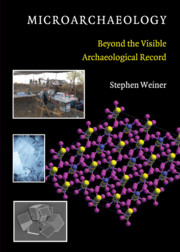Book contents
- Frontmatter
- Contents
- Preface
- 1 Archaeology, Archaeological Science, and Microarchaeology
- 2 Information Embedded in the Microscopic Record
- 3 Completeness of the Archaeological Record
- 4 Common Mineral Components of the Archaeological Record
- 5 Biological Materials: Bones and Teeth
- 6 Biological Materials: Phytoliths, Diatoms, Eggshells, Otoliths, and Mollusk Shells
- 7 Reconstructing Pyrotechnological Processes
- 8 Biological Molecules and Macromolecules: Protected Niches
- 9 Ethnoarchaeology of the Microscopic Record: Learning from the Present
- 10 Absolute Dating: Assessing the Quality of a Date
- 11 Reading the Microscopic Record On-Site
- 12 Infrared Spectroscopy in Archaeology
- Appendix A Identifying Minerals Using Microchemical Analysis
- Appendix B Identifying Minerals and Compounds Using Infrared Spectra: Table of Standard Minerals and Compounds for Which Infrared Spectra Are Available
- References
- Index
- Plates section
12 - Infrared Spectroscopy in Archaeology
Published online by Cambridge University Press: 05 June 2012
- Frontmatter
- Contents
- Preface
- 1 Archaeology, Archaeological Science, and Microarchaeology
- 2 Information Embedded in the Microscopic Record
- 3 Completeness of the Archaeological Record
- 4 Common Mineral Components of the Archaeological Record
- 5 Biological Materials: Bones and Teeth
- 6 Biological Materials: Phytoliths, Diatoms, Eggshells, Otoliths, and Mollusk Shells
- 7 Reconstructing Pyrotechnological Processes
- 8 Biological Molecules and Macromolecules: Protected Niches
- 9 Ethnoarchaeology of the Microscopic Record: Learning from the Present
- 10 Absolute Dating: Assessing the Quality of a Date
- 11 Reading the Microscopic Record On-Site
- 12 Infrared Spectroscopy in Archaeology
- Appendix A Identifying Minerals Using Microchemical Analysis
- Appendix B Identifying Minerals and Compounds Using Infrared Spectra: Table of Standard Minerals and Compounds for Which Infrared Spectra Are Available
- References
- Index
- Plates section
Summary
The identification of materials and their characterization is, in many respects, the key to elucidating the microscopic archaeological record. Among all the methods used for this purpose in archaeology, infrared spectroscopy is one of the most useful. Infrared spectra are easy to obtain but can be difficult to interpret. The purpose of this chapter is to provide information on interpreting infrared spectra of archaeological materials as well as to review some of the more common applications. The latter are referred to as overviews in this chapter and throughout the book.
Infrared spectroscopy is a sensitive method for obtaining information on the molecular structures of crystalline and amorphous/ disordered materials as well as organic materials. Infrared spectroscopy can thus be used both to identify materials and to characterize their states of atomic order and disorder. In these respects, infrared spectroscopy is similar to powder X-ray diffraction, although the latter cannot be used to identify and characterize amorphous and highly disordered materials. Amorphous and highly disordered materials are common in archaeology.
Infrared spectroscopy is based on the manner in which radiation interacts with material in the infrared range (4,000 to 250 centimeter−1 [cm–1; wavenumbers, or the inverse of wavelength]). Some of this radiation is absorbed by the sample because it causes the chemical bonds of the sample to vibrate. The result is that less radiation reaches the detector at specific wavenumbers, and this is recorded as a series of peaks in the infrared absorbance spectrum.
- Type
- Chapter
- Information
- MicroarchaeologyBeyond the Visible Archaeological Record, pp. 275 - 316Publisher: Cambridge University PressPrint publication year: 2010



